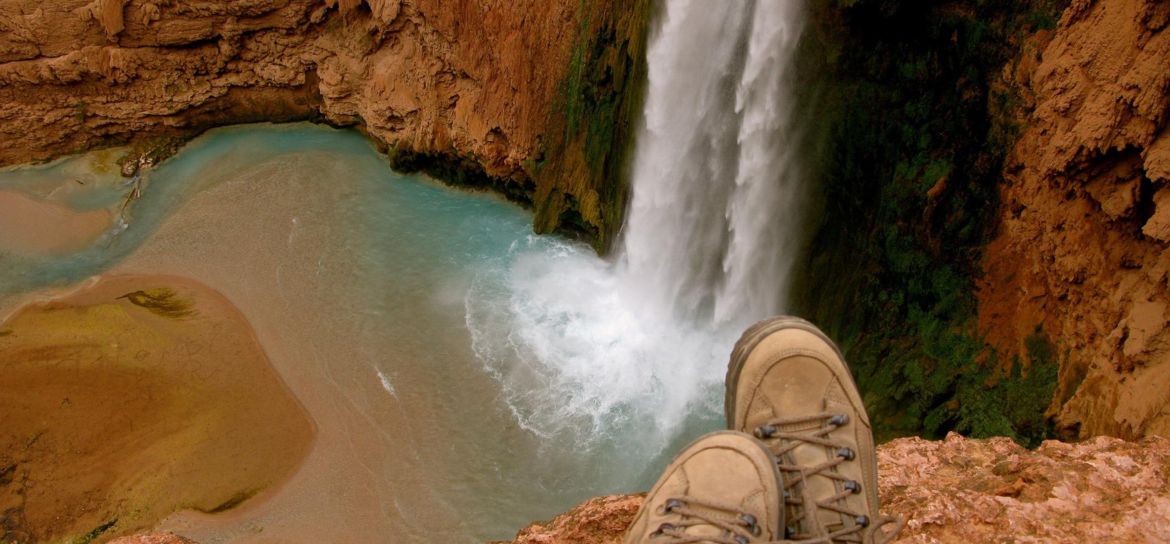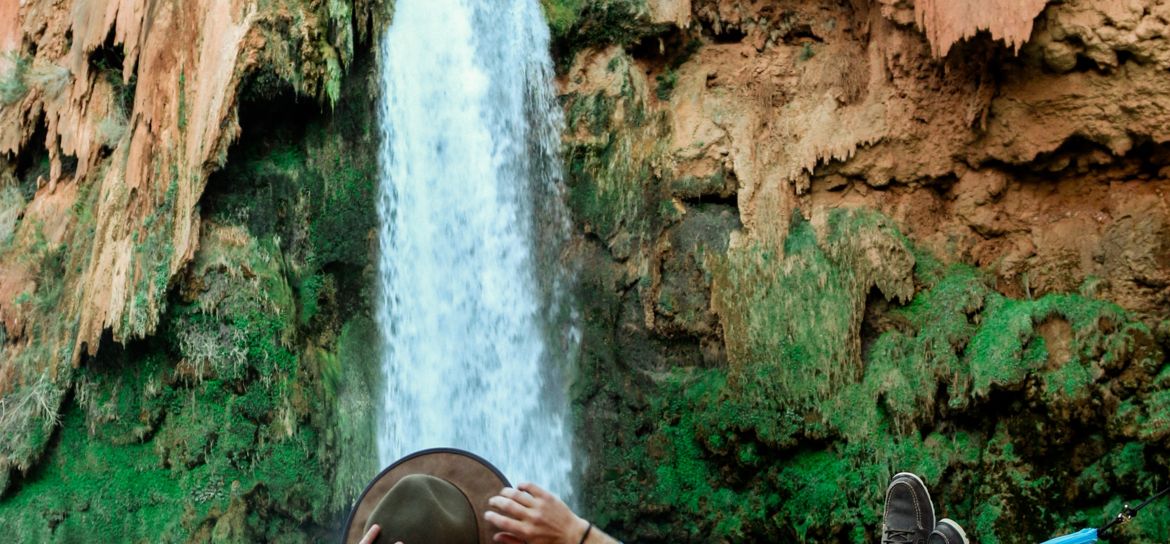
Guide To Visiting Havasu Falls
Havasupai Falls is the most well known oasis in all of the Grand Canyon. The famous photos of turquoise and blue/green waterfalls spilling over rust red and bright orange cliffs deep in the recesses of America's deepest canyon beckons travelers from all over the world to this amazing site.
The waters of Havasu Creek, which are the source of the crown jewel of riparian areas within the Grand Canyon, flow in a lush side canyon and form a series of five waterfalls.
Havasupai Falls include Havasu Falls, the most photographed, easiest to access and by far the most famous. The other waterfalls are located further downstream and include Navajo Falls, Fifty Foot Falls, Mooney Falls, and Beaver Falls.
Located on the Havasupai Indian reservation, Havasupai Falls is remote, beautiful, and requires a reservation to access.
Prepare to embark on a strenuous hike to revel in its beauty. This true backcountry experience – no hotels, no air conditioning, no five star restaurants – so in this guide, we’ll cover the basics of how to get to Havasu Falls, the permits and reservations required to access the Havasupai Indian reservation site, and what to bring on your trip to make it comfortable and successful.
Note: Due to COVID-19, all tourism at Havasupai is currently suspended through the end of 2022.

When To Visit Havasu Falls
The official season to visit Havasupai runs from February to November each permit season.
If you visit in February or November expect thinner crowds, cooler days and nights, and a chiller creek. But this shoulder season also offer some of the most beautiful water in the entire canyon.
March/April and September/October offer perfect weather but are much busier. During the summer, from June to August, the trail is subject to extreme heat, which can rise up to 115°F.
Havasupai Falls Reservations
Havasu Falls sits on the Havasupai Indian Reservation - which is not part of Grand Canyon National Park - so you'll need to buy a permit from the Havasupai Tribe to access the area. This applies to Campground, Lodge, and Pack Mule reservations.
The Havasupai Tribe looks forward to welcoming tourists back for the 2025 tourist season.
Where is Havasu Falls
Havasu Falls is located on the Havasupai Indian Reservation, just outside of Grand Canyon National Park.
Havasu Falls is not located near Lake Havasu. That is five hours away from this remote canyon outpost.
To access Havasu Falls a ten-mile hike is required from the Havasu/Moony/Beaver Falls, trailhead. The starting point for this trail is the Hualapai Hilltop Parking Lot (5,174 feet).

Directions To Havasu Falls Trailhead
All hikes to Havasu Falls begin and end at Hualapai Hilltop. This trailhead's remote location is not easy to find so here are precise directions from major Southwest cities.
Havasu Falls Trailhead From Flagstaff
Here is how to get to Havasupai trailhead from Flagstaff.
Distance: 3.5 hours
Directions:
- Drive west on I-40
- Take the I-40 Business Exit, Exit 123, toward AZ-66/Seligman/Peach Springs
- Turn Right on Indian Road 18 for approximately 60 miles. Road ends at Hilltop (the trailhead)
Havasu Falls Trailhead From Las Vegas
Here is how to get to the Havasupai trailhead from Las Vegas.
Distance: 3.5 hours
Directions:
- Take US-93 South from Las Vegas and follow it for 105 mies
- At Kingman, merge onto I-40 E/US-93 S toward Flagstaff/Phoenix for 4 miles.
- Take the Andy Devine Avenue exit (Exit 53) toward AZ-66 E/Kingman Airport
- Turn left onto US-93 Bus S (E Andy Devine Avenue) and continue to follow E Andy Devine Avenue
- E Andy Devine Avenue becomes E Highway 66/AZ-66, and follow this for 50 miles
- Turn Left on Indian Road 18 for approximately 60 miles. Road ends at Hilltop (the trailhead)
Havasu Falls Trailhead From Phoenix
Here is how to get to the Havasupai trailhead from Phoenix.
Distance: 4.5 hours
Directions:
- Drive north on I-17 and exit onto AZ-69 N at Exit 262 toward Prescott
- After 21 miles merge onto AZ-89 toward Chino Valley
- Continue on AZ-89 to I-40 and go west on I-40
- Take the I-40 Business Exit, Exit 123, toward AZ-66/Seligman/Peach Springs
- Turn Right on Indian Road 18 for approximately 60 miles. Road ends at Hilltop (the trailhead)

What You’ll Need To Visit Havasu Falls
There are a few "must haves" before you visit Havasu Falls. The most important items include
- A permit
- A prior reservation
Hiking and camping at Havasu Falls is not a glamping trip. You are required to bring all of your own equipment with you to stay overnight in the canyon (minimum stay of 3 nights on each reservation).
Here is a list of recommended gear you'll need for any Havasu Falls camping trip:
- Hiking boots or shoes
- A 65 liter or more backpack capable of fitting all your gear for the multi-day trip
- Trekking poles to save your knees on the ascent and descent
- Tent
- Sleeping bag
- Sleeping pad
- Camelback that fits into your backpack for 10-mile plus hike down
- Sunscreen, hat, sunglasses
- Camp clothes/socks
- Swimsuit for warmer months
- Waterproof shoes river crossings. Tevas or Bedrocks recommended
- Camp stove to boil water
- Dehydrated food
- Headlamp

Havasu Falls Hike
The trek to Havasu Falls is difficult. It is located in the remote wilderness of the Grand Canyon and is approximately 10 miles in each direction.
You'll start from the Hualapai Hilltop and descend about 2,5000 vertical feet with the majority of that distance being rocky, sandy, and without shade.
For example, the first two miles when you descend into the canyon are a series of tight switchbacks that drop you down 1,800 feet quickly. You'll ascend this same stretch on the way out as the hike is not a loop but out and back. The hike to the falls is all downhill, which means that the hike out involves a considerable amount of elevation gain and is all uphill. The difficulty is compounded by heat in the summer.
Once you reach the bottom of the Grand Canyon, the next six miles of the hike to Supai is flat, dusty, and hot. Kick up your feet and take a break once you reach Supai, eight miles from the canyon rim. Supai is considered the most remote community in the lower 48. It's the only place in the United States where mail is still carried out by mules.This outpost has a general store and cafe where food and drinks can be purchased.
Once you reach Supai, the hike continues for two more miles before it reaches the first waterfall, Havasu Falls, and the campground. At Havasu Falls, set up your camp and take a dip in the surreal aqua-blue water pouring over the limestone cliffs.
After, you have the option of day-hiking to the other falls but, after Havasu Falls, the hike becomes much more challenging. In some sections, hikers are required to use wall chains, wood ladders, and cross Havasu Creek numerous times. Be prepared to hike across technical, rocky areas with wet feet.
The Havasu Falls Trail will have you scrambling on misty canyon walls while holding onto chains bolted into Grand Canyon walls; what an adventure! Adventurous hikers can go all the way to the Colorado River.

Camping Havasupai Falls
All Havasu campground reservations are made at HavasupaiReservations.com. Anyone who is interested in camping at Havasupai Falls needs to create an account here.
Reservations for the following season usually open February 1.
The designated campground area spans both sides of Havasu Creek between Havasu Falls and Mooney Falls. In this approximately one-mile area there are no assigned sites. You're welcome to set up camp wherever you like within this designated area.
All campground reservations are for three nights and four days.The Havasupai Tribe does not let campers deviate from this format.
While prices always change, expect to pay about $50 per person entrance fee, $25 plus per night, per person to camp, and an environmental fee per person as well.
All in, you are looking at between $100-$125 per day to camp in this unique, beautiful, fragile environment.
Havasupai Lodge
The Havasupai Lodge is located in the village of Supai.
Unlike making a reservation for the campground, which is online-only, the Lodge only accepts reservations by phone. Call (928) 448-2111 to book a room for dates between February 1 - November 30.
Lodge rates run approximately $440 per night for a four-person room, plus a $110 entrance and environmental fee per person. These fees also include your permits and taxes.

Important information about visiting Havasu Falls
A trip to Havasu Falls is remote, requires significant planning, and a number of permits.
Here are some important tips to consider while you plan your trip:
- You must have permits and reservations to camp overnight and visit Havasu Falls. Do not drive to the trailhead and think you can take a day trip into the waterfalls. You will be turned away.
- Following the tribe rules is essential and non negotiable. Entrance onto the Havasupai Reservation is conditioned upon the Tourist's consent to the Tribe's civil regulatory and civil adjudicatory jurisdiction.
- Cell phone service is not available during the hike, in Supi, or at the campground.
- Plan to carry one gallon of water per person on the hike. There is absolutely any water available on the trail from the trail head parking lot until Supai Village. When starting your hike, bring enough water for the 10 mile hike down to the campground where a water spigot with fresh water is available.
- This is a very crowded hike. Permits always sell out. You will not have Havasu Falls to yourself. If you are looking for solitude, move along.
- The temperatures often reach more than 100 degrees in the summer. Plan to hike in the coolest part of the day, when the canyon is shady. Sunscreen and sunhats are always recommended.
- Watch out for scorpions or snakes.
- Do not hike alone. Keep your group together at all times.
- Wear sturdy closed-toed, tennis or hiking boots/shoes with good ankle support. Water shoes or rubber sandals are recommended when you are in the water.
- There are no public health facilities in the village. In the event of an injury, it may take many hours to get treatment or be transported out of the canyon.
- Flash flooding can occur anytime but is more frequent during monsoon season; June-August. Watch for rain and dark clouds especially in the south and move to high elevations once moisture hits.
While not part of Grand Canyon National Park Havasupai is close to other popular attractions in the region. Check out our Grand Canyon National Park guide and, if you are in the region, Grand Canyon Skywalk is a must see attraction. Our Grand Canyon West guide cover this and other worthwhile attractions in the area.